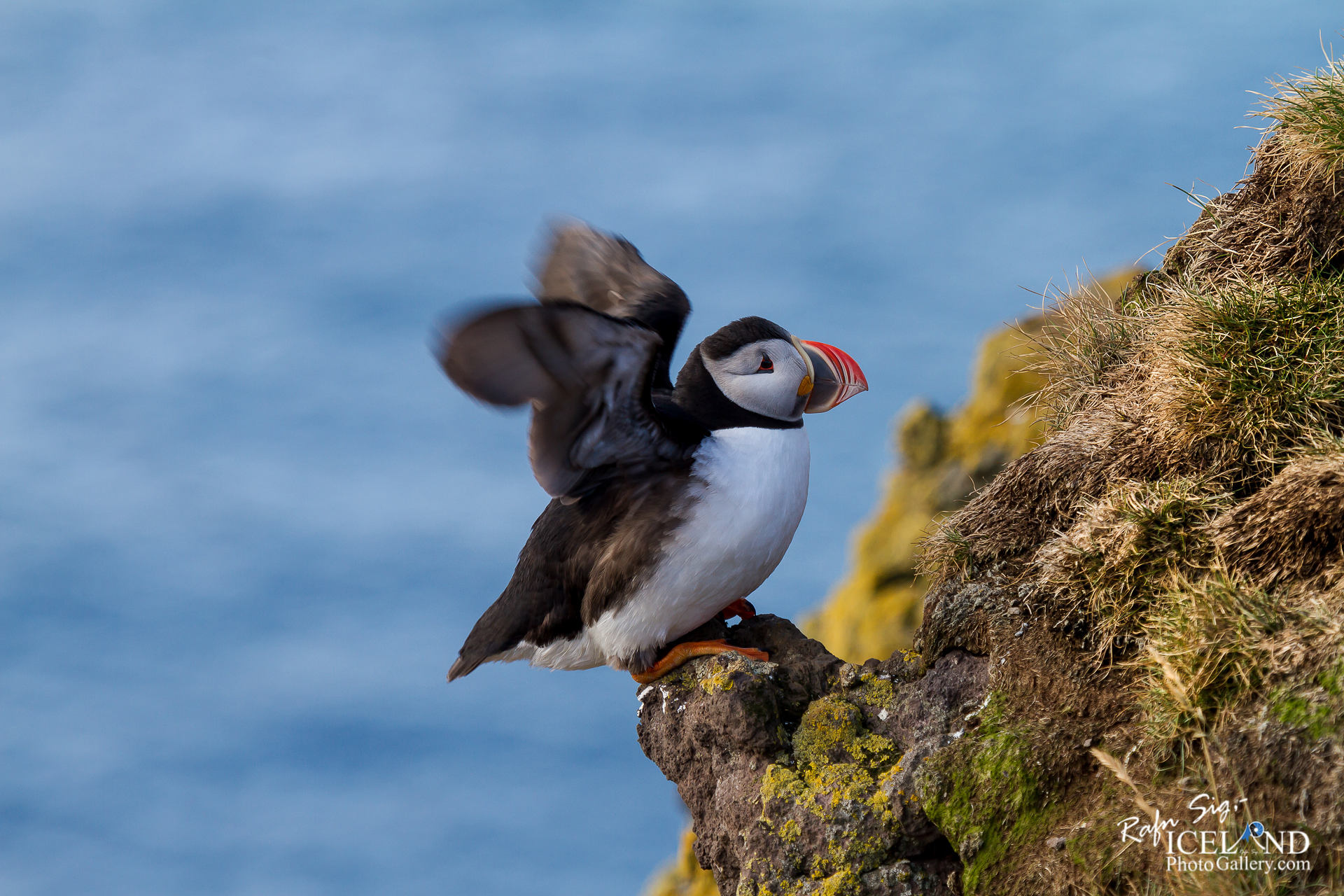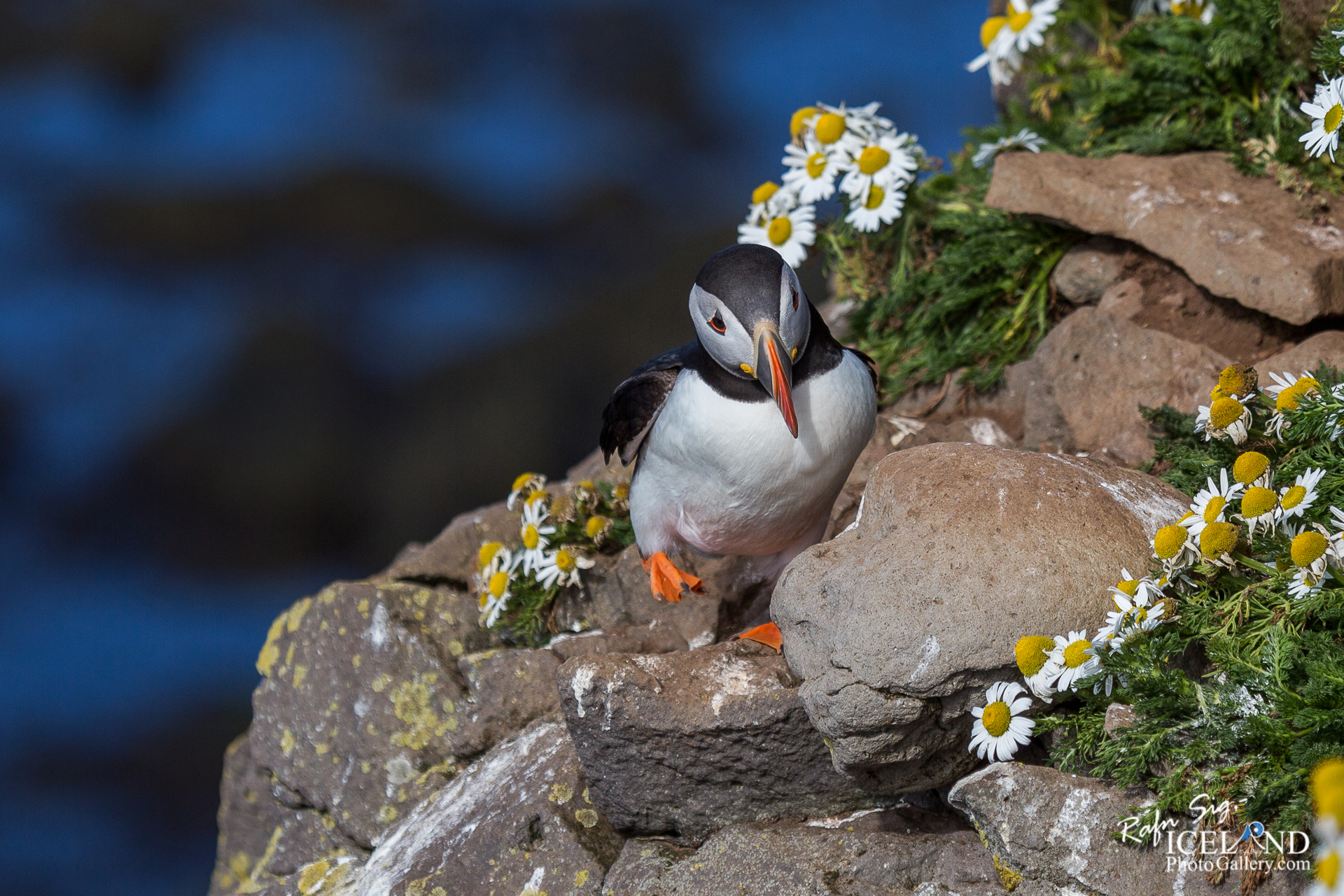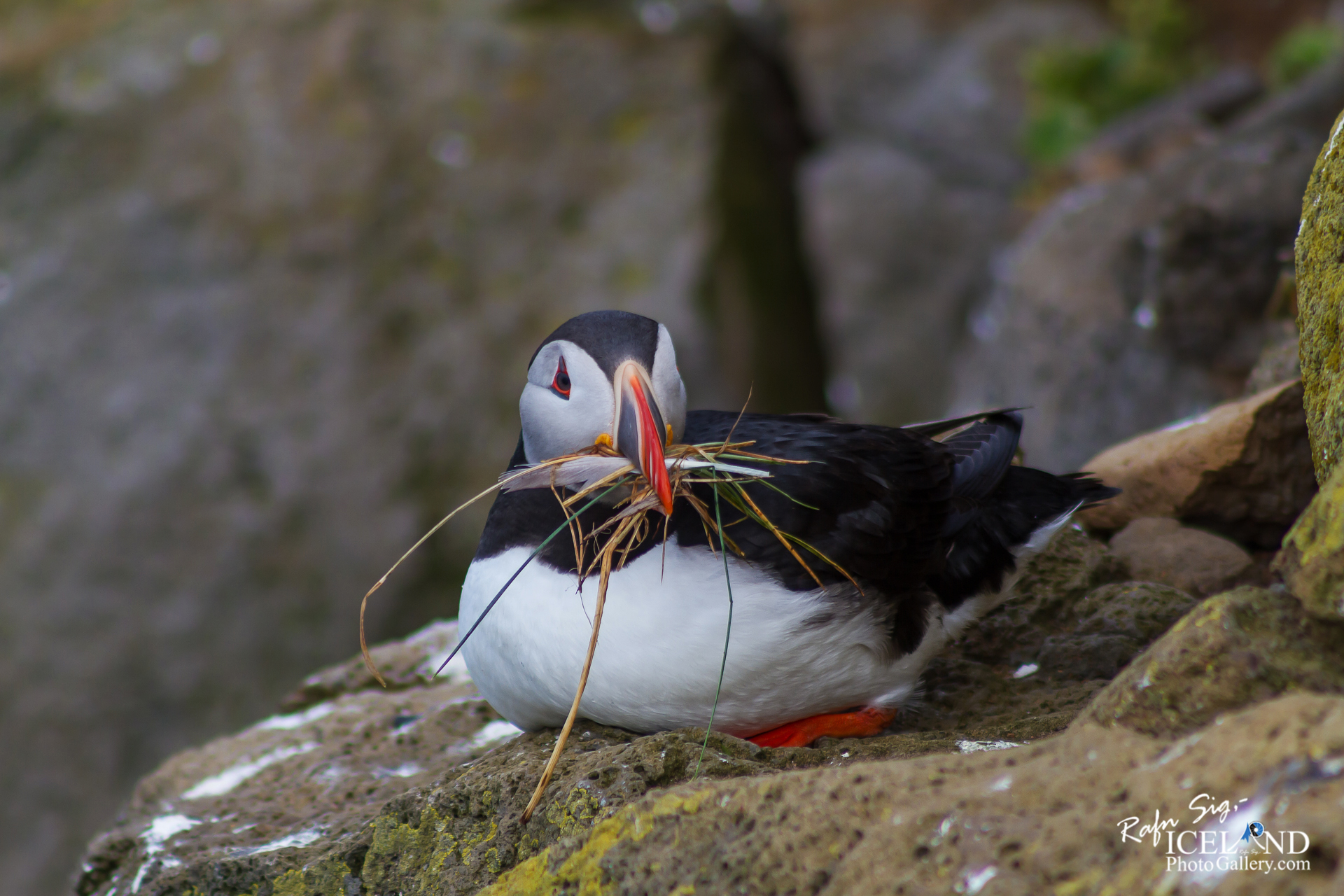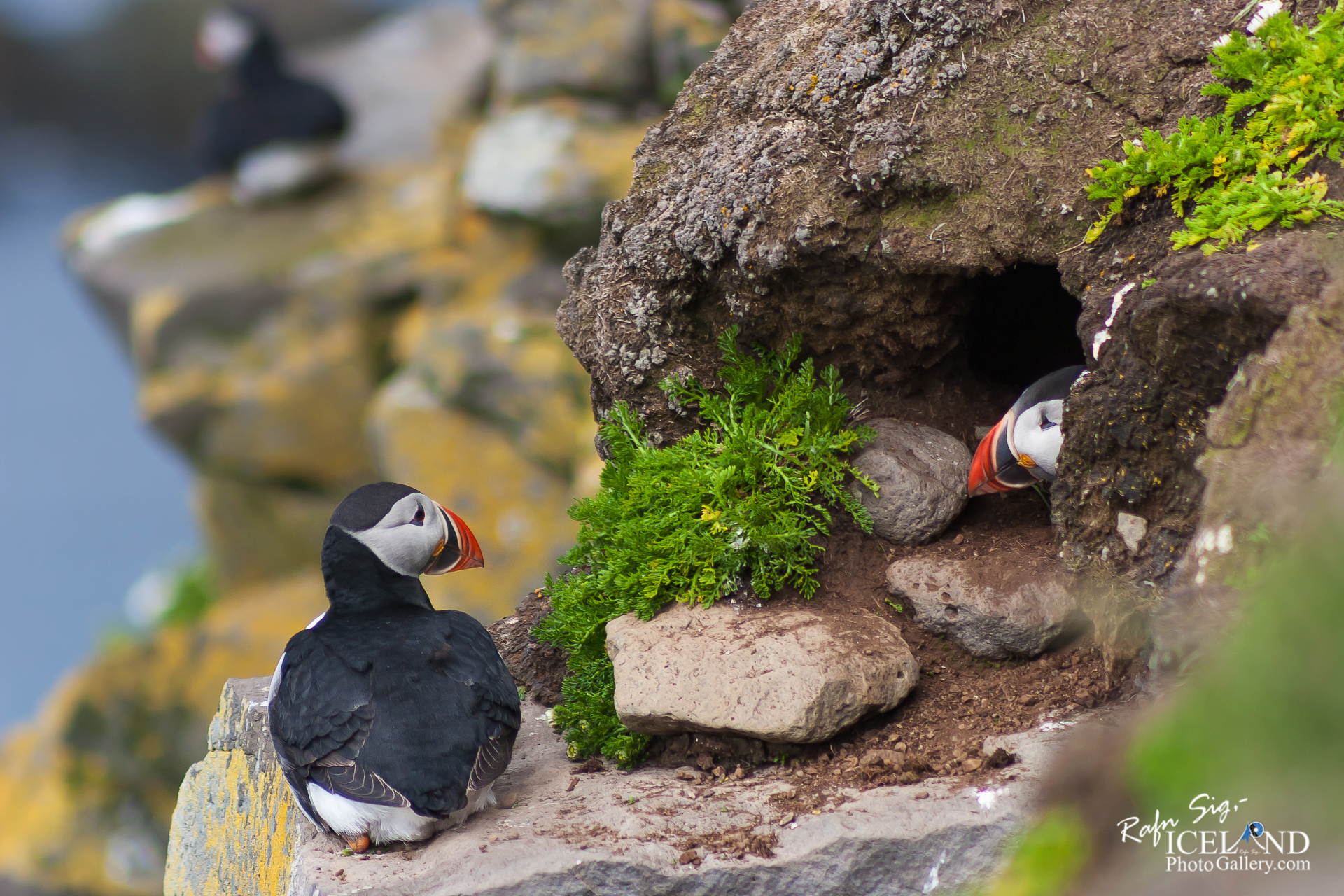2022-06-01
Lundi (Puffin) (Fratercula arctica) │ Iceland Photo Gallery
Documenting Iceland
by: Rafn Sig,-

Lundi er einn af minni svartfuglunum og jafnframt sá algengasti. Hann er fremur höfuðstór og kubbslegur. Fullorðinn lundi í sumarbúningi er svartur að ofan og hvítur að neðan með svartan koll og svartan kraga um háls. Höfuðhliðar (vangar) eru gráar, undirvængir svartir og goggur í skærum litum. Á veturna eru vangar dekkri og goggur litdaufari og minni. Kynin eru eins. Ungfugl er svipaður en goggur mjórri og svæðið framan augna dekkra.
Lundinn flýgur beint með hröðum vængjatökum, venjulega lágt yfir haffleti. Hann stendur uppréttur og á auðvelt með gang. Samanreknari en hinir stærri svartfuglar, höfuðlag er annað og engar vængrákir. Afar félagslyndur. Yfirleitt þögull en á varpstöðvunum heyrist kurrandi hljóð, bæði úr holum og frá sitjandi fuglum. Lundinn kafar eftir æti og syndir kafsund með vængjunum. Getur kafað niður á 60 m dýpi og verið í 1,5 mín. í kafi. Raðar fiskunum í gogginn, ber oftast 6–20 fiska í ferð. Aðalfæðan er síli (sandsíli, marsíli og trönusíli), loðna er einnig mikilvæg, tekur einnig seiði ýmissa fiska, svo og sænál, ljósátu o.fl.
Lundinn heldur sig á grunnsævi á sumrin. Hann verpur í byggðum í grösugum eyjum, höfðum og brekkum ofan við bjargbrúnir eða í urðum undir þeim. Fuglinn grefur sér holu í svörð eða verpur undir steinum og í glufum. Hreiðurkiminn innst í holunni, sem getur verið krókótt og með mörgum opum, er fóðraður með þurrum gróðri.
Lundinn er farfugl. Þegar liðið er á varptímann fara ungfuglar að flakka á milli og heimsækja vörpin. Lundastofninn er mjög stór og eru stærstu byggðirnar í Vestmannaeyjum og Breiðafjarðareyjum. Ungi lundans nefnist kofa eða pysja. Að varptíma loknum hverfur lundinn út á Norður-Atlantshafið. (Heimildir: Fuglavefurinn)
The Atlantic puffin (Fratercula arctica), also known as the common puffin, is a species of seabird in the auk family. It is the only puffin native to the Atlantic Ocean; two related species, the tufted puffin and the horned puffin, are found in the northeastern Pacific. Although it has a large population and a wide range, the species has declined rapidly, at least in parts of its range, resulting in it being rated as vulnerable by the IUCN. On land, it has the typical upright stance of an auk. At sea, it swims on the surface and feeds mainly on small fish, which it catches by diving under water, using its wings for propulsion.
This puffin has a black crown and back, pale grey cheek patches, and white underparts. Its broad, boldly marked red-and-black beak and orange legs contrast with its plumage. It moults while at sea in the winter, and some of the brightly coloured facial characteristics are lost, with colour returning again during the spring. The external appearances of the adult male and female are identical, though the male is usually slightly larger. The juvenile has similar plumage, but its cheek patches are dark grey. The juvenile does not have brightly coloured head ornamentation, its bill is narrower and is dark-grey with a yellowish-brown tip, and its legs and feet are also dark. Puffins from northern populations are typically larger than in the south and these populations are generally considered a different subspecies.
Spending the autumn and winter in the open ocean of the cold northern seas, the Atlantic puffin returns to coastal areas at the start of the breeding season in late spring. It nests in clifftop colonies, digging a burrow in which a single white egg is laid. Chicks mostly feed on whole fish and grow rapidly. After about 6 weeks, they are fully fledged and make their way at night to the sea. They swim away from the shore and do not return to land for several years.
Atlantic puffins lead solitary existences when out at sea, and this part of their lives has been little studied, as the task of finding even one bird on the vast ocean is formidable. When at sea, they bob about like a cork, propelling themselves through the water with powerful thrusts of their feet and keeping turned into the wind, even when resting and apparently asleep. They spend much time each day preening to keep their plumage in order and spread oil from their preen glands. Their downy under plumage remains dry and provides thermal insulation. In common with other seabirds, their upper surface is black and underside white. This provides camouflage, with aerial predators unable to locate the birds against the dark, watery background, and underwater attackers fail to notice them as they blend in with the bright sky above the waves
Having spent the winter alone on the ocean, whether the Atlantic puffin meets its previous partner offshore or whether they encounter each other when they return to their nest of the previous year is unclear. On land, they soon set about improving and clearing out the burrow. Often, one stands outside the entrance while the other excavates, kicking out quantities of soil and grit that showers the partner standing outside.
Atlantic puffins are sexually mature at 4–5 years old. They are colonial nesters, excavating burrows on grassy cliff tops or reusing existing holes, and on occasion may nest in crevices and among rocks and scree, in competition with other birds and animals for burrows. They can excavate their own hole or move into a pre-existing system dug by a rabbit, and have been known to peck and drive off the original occupant. (References: Wikipedia)
. . . All info at: https://www.patreon.com/RafnSig
Subscribe to my Youtube Channel
You can buy this and other photos at my Icelandic Stock Photo Web: IcelandStockPhotos.com
Viltu styrkja þessa síðu?
Vefsíðan Iceland Photo Gallery er unnin í sjálfboðavinnu. Ef þú hefur áhuga á að styrkja þetta framtak til áframhaldandi uppbyggingar er hægt að leggja inn á:
Reikningsnr.: 0101-26-013169
Kennitala: 310155-4469













0 Comments